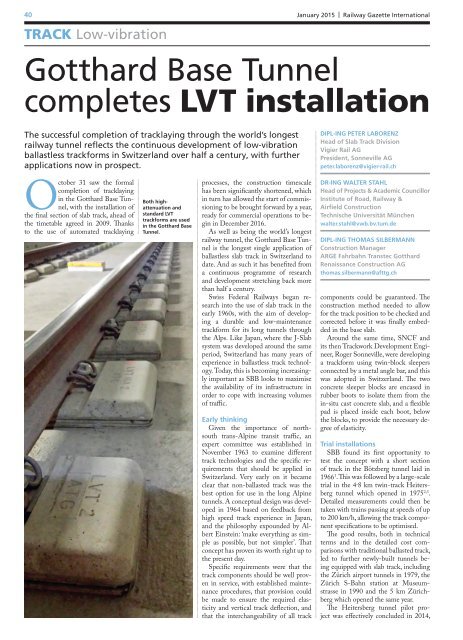Rail conquers the Alps
1spJ1Ka
1spJ1Ka
Create successful ePaper yourself
Turn your PDF publications into a flip-book with our unique Google optimized e-Paper software.
40 January 2015 | <strong>Rail</strong>way Gazette International<br />
TRACK Low-vibration<br />
Gotthard Base Tunnel<br />
completes LVT installation<br />
The successful completion of tracklaying through <strong>the</strong> world’s longest<br />
railway tunnel reflects <strong>the</strong> continuous development of low-vibration<br />
ballastless trackforms in Switzerland over half a century, with fur<strong>the</strong>r<br />
applications now in prospect.<br />
DIPL-ING PETER LABORENZ<br />
Head of Slab Track Division<br />
Vigier <strong>Rail</strong> AG<br />
President, Sonneville AG<br />
peter.laborenz@vigier-rail.ch<br />
October 31 saw <strong>the</strong> formal<br />
completion of tracklaying<br />
in <strong>the</strong> Gotthard Base Tunnel,<br />
with <strong>the</strong> installation of<br />
<strong>the</strong> final section of slab track, ahead of<br />
<strong>the</strong> timetable agreed in 2009. Thanks<br />
to <strong>the</strong> use of automated tracklaying<br />
Both highattenuation<br />
and<br />
standard LVT<br />
trackforms are used<br />
in <strong>the</strong> Gotthard Base<br />
Tunnel.<br />
processes, <strong>the</strong> construction timescale<br />
has been significantly shortened, which<br />
in turn has allowed <strong>the</strong> start of commissioning<br />
to be brought forward by a year,<br />
ready for commercial operations to begin<br />
in December 2016.<br />
As well as being <strong>the</strong> world’s longest<br />
railway tunnel, <strong>the</strong> Gotthard Base Tunnel<br />
is <strong>the</strong> longest single application of<br />
ballastless slab track in Switzerland to<br />
date. And as such it has benefited from<br />
a continuous programme of research<br />
and development stretching back more<br />
than half a century.<br />
Swiss Federal <strong>Rail</strong>ways began research<br />
into <strong>the</strong> use of slab track in <strong>the</strong><br />
early 1960s, with <strong>the</strong> aim of developing<br />
a durable and low-maintenance<br />
trackform for its long tunnels through<br />
<strong>the</strong> <strong>Alps</strong>. Like Japan, where <strong>the</strong> J-Slab<br />
system was developed around <strong>the</strong> same<br />
period, Switzerland has many years of<br />
experience in ballastless track technology.<br />
Today, this is becoming increasingly<br />
important as SBB looks to maximise<br />
<strong>the</strong> availability of its infrastructure in<br />
order to cope with increasing volumes<br />
of traffic.<br />
Early thinking<br />
Given <strong>the</strong> importance of northsouth<br />
trans-Alpine transit traffic, an<br />
expert committee was established in<br />
November 1963 to examine different<br />
track technologies and <strong>the</strong> specific requirements<br />
that should be applied in<br />
Switzerland. Very early on it became<br />
clear that non-ballasted track was <strong>the</strong><br />
best option for use in <strong>the</strong> long Alpine<br />
tunnels. A conceptual design was developed<br />
in 1964 based on feedback from<br />
high speed track experience in Japan,<br />
and <strong>the</strong> philosophy expounded by Albert<br />
Einstein: ‘make everything as simple<br />
as possible, but not simpler’. That<br />
concept has proven its worth right up to<br />
<strong>the</strong> present day.<br />
Specific requirements were that <strong>the</strong><br />
track components should be well proven<br />
in service, with established maintenance<br />
procedures, that provision could<br />
be made to ensure <strong>the</strong> required elasticity<br />
and vertical track deflection, and<br />
that <strong>the</strong> interchangeability of all track<br />
DR-ING WALTER STAHL<br />
Head of Projects & Academic Councillor<br />
Institute of Road, <strong>Rail</strong>way &<br />
Airfield Construction<br />
Technische Universität München<br />
walter.stahl@vwb.bv.tum.de<br />
DIPL-ING THOMAS SILBERMANN<br />
Construction Manager<br />
ARGE Fahrbahn Transtec Gotthard<br />
Renaissance Construction AG<br />
thomas.silbermann@afttg.ch<br />
components could be guaranteed. The<br />
construction method needed to allow<br />
for <strong>the</strong> track position to be checked and<br />
corrected before it was finally embedded<br />
in <strong>the</strong> base slab.<br />
Around <strong>the</strong> same time, SNCF and<br />
its <strong>the</strong>n Trackwork Development Engineer,<br />
Roger Sonneville, were developing<br />
a trackform using twin-block sleepers<br />
connected by a metal angle bar, and this<br />
was adopted in Switzerland. The two<br />
concrete sleeper blocks are encased in<br />
rubber boots to isolate <strong>the</strong>m from <strong>the</strong><br />
in-situ cast concrete slab, and a flexible<br />
pad is placed inside each boot, below<br />
<strong>the</strong> blocks, to provide <strong>the</strong> necessary degree<br />
of elasticity.<br />
Trial installations<br />
SBB found its first opportunity to<br />
test <strong>the</strong> concept with a short section<br />
of track in <strong>the</strong> Bötzberg tunnel laid in<br />
1966 1 . This was followed by a large-scale<br />
trial in <strong>the</strong> 4·8 km twin-track Heitersberg<br />
tunnel which opened in 1975 2,3 .<br />
Detailed measurements could <strong>the</strong>n be<br />
taken with trains passing at speeds of up<br />
to 200 km/h, allowing <strong>the</strong> track component<br />
specifications to be optimised.<br />
The good results, both in technical<br />
terms and in <strong>the</strong> detailed cost comparisons<br />
with traditional ballasted track,<br />
led to fur<strong>the</strong>r newly-built tunnels being<br />
equipped with slab track, including<br />
<strong>the</strong> Zürich airport tunnels in 1979, <strong>the</strong><br />
Zürich S-Bahn station at Museumstrasse<br />
in 1990 and <strong>the</strong> 5 km Zürichberg<br />
which opened <strong>the</strong> same year.<br />
The Heitersberg tunnel pilot project<br />
was effectively concluded in 2014,


